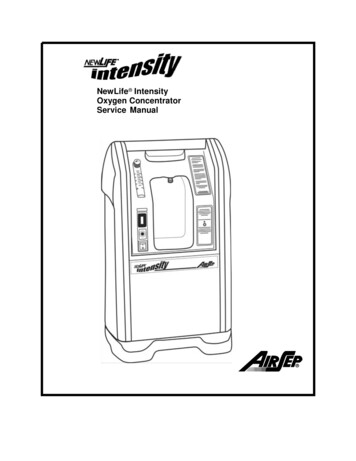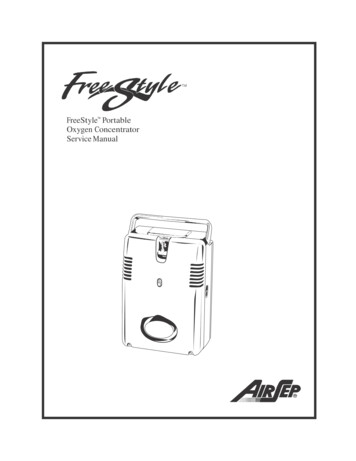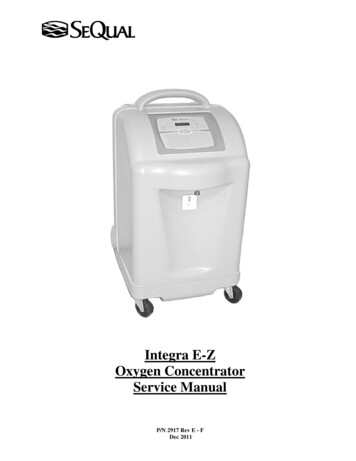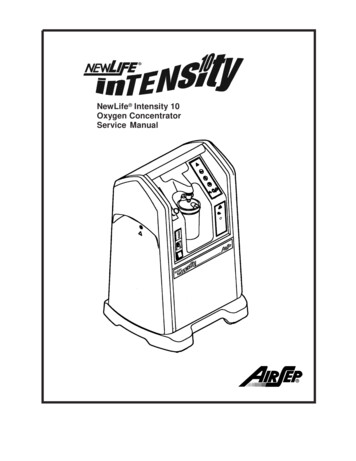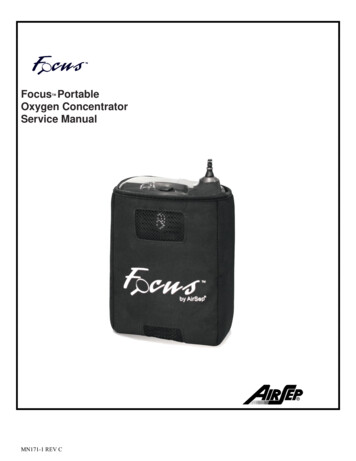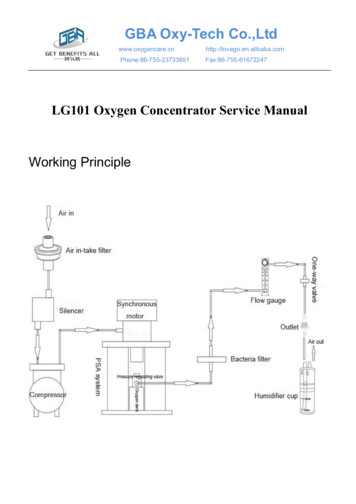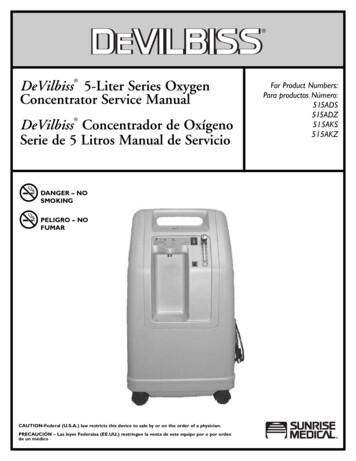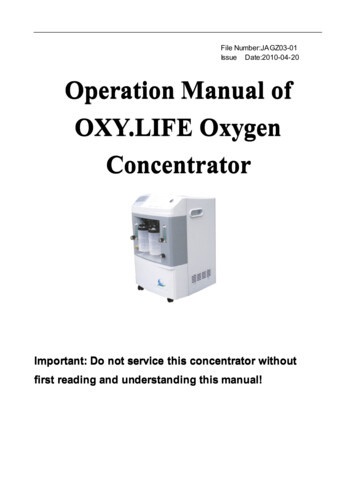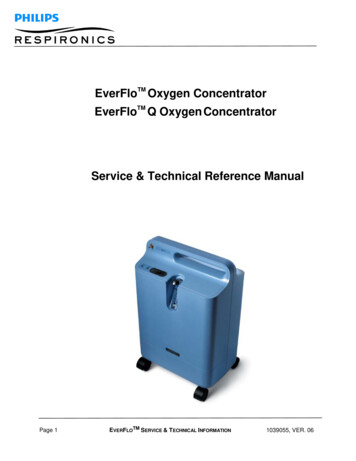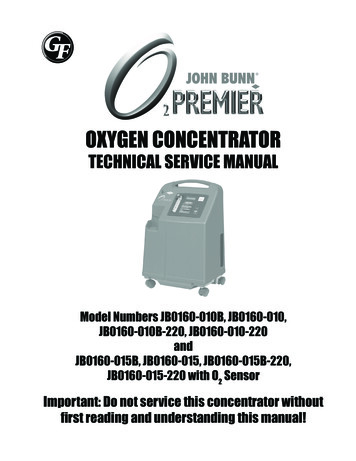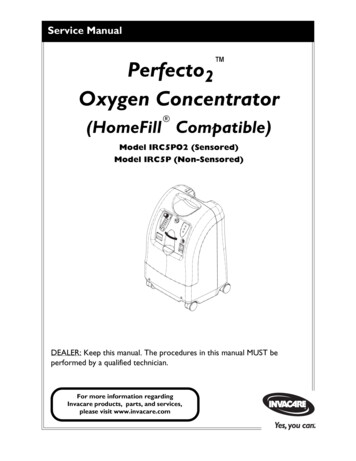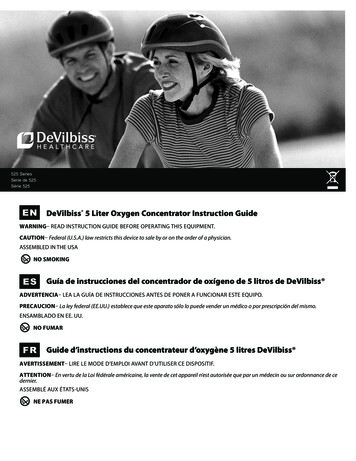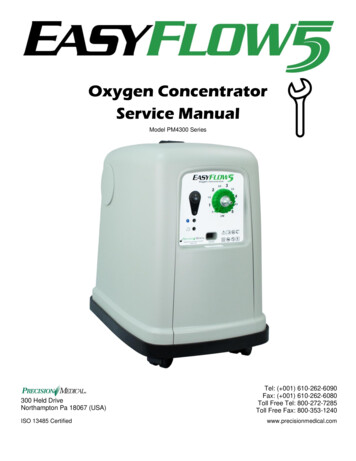
Transcription
Oxygen ConcentratorService ManualModel PM4300 Series300 Held DriveNorthampton Pa 18067 (USA)ISO 13485 CertifiedTel: ( 001) 610-262-6090Fax: ( 001) 610-262-6080Toll Free Tel: 800-272-7285Toll Free Fax: 800-353-1240www.precisionmedical.com
ContentsPreface . 1Definition of terms . 1Safety Symbols information - Warnings and Cautions . 2Theory of Operation . 3Warnings and Cautions . 4Specifications: . 5Component Description . 6External. 6Internal . 7Miscellaneous . 8Maintenance / Cleaning . 8Cabinet: . 8Inlet Filter: . 9Returns . 9Disposal Instructions . 9Troubleshooting . 9Alarm Indicators . 11Front Panel Assembly Replacement . 12Disassembly . 12Reassembly . 13Dial Flowmeter Replacement (506620) . 14Disassembly . 14Reassembly . 14Compressor Assembly Replacement (507322) . 15Disassembly . 15Reassembly . 16Sieve Bed Assembly Replacement (506418) . 17Disassembly . 17Reassembly . 17Final Test. 18
PrefacePrecision Medical, Inc.300 Held DriveNorthampton, PA 18067 USACustomer Service / Tech SupportPhone: 1-610-262-6090Phone: 1-800-272-7285Fax: 1-610-262-6080Web: www.precisionmedical.comThis manual is intended to guide and help a qualified service technician in the safe handling, service, repair andperformance verification of the PM4300 Series “EasyFlow 5” Stationary Oxygen Concentrator. A qualified servicetechnician should be trained in the safe handling of oxygen equipment and understand its inherent dangers.DO NOT attempt to use or perform any service function on the PM4300 series Stationary Oxygen Concentrator unlessyou have read and understand this manual as well as the User Manual.Definition of termsACESDSOCOVPPCBAlternating CurrentElectro Static DischargeStationary Oxygen ConcentratorOperation Verification ProcedurePrinted Circuit Board1
Safety Symbols information - Warnings and CautionsDANGERIndicates an imminently hazardous situation which, if not avoided, will result in death orserious injury.WARNINGIndicates a potentially hazardous situation which, if not avoided, could result in death orserious injury.CAUTIONIndicates a potentially hazardous situation which, if not avoided, may result in minor ormoderate injury.CAUTIONUsed without the safety alert symbol indicates a potentially hazardous situation which, ifnot avoided, may result in property damage.PM4300 Series with respect to electrical shock, fire and mechanical hazards only inaccordance with ANSI/AAMI ES60601-1 (2005, 3rd ed), CAN/CSAC22.2 No. 60601-1(2008) 62NAFollow instructions for useGeneral Mandatory Action SignDangerous VoltageNo SmokingGeneral AlarmType BF EquipmentNo Oil or GreaseThis device may contain electrical components that are hazardous to the environment. DONOT dispose device into standard trash. Contact your local waste management fordisposal of Electronic Equipment.2
Theory of OperationAir enters the system through the compressor intake muffler/filter (1). The compressor (2) increases the air pressure toapproximately 30 psig (2 Bar). The compressed air is then directed through the dual solenoid valve (4) (see note) to oneof the molecular sieve beds (5 or 6). As compressed air passes through the selected sieve bed, nitrogen is stripped fromthe air and a high concentration of oxygen passes through. After a predetermined time, the dual solenoid reversesoperation, and compressed air passes thru the other sieve bed.Note: The dual solenoid valve is controlled by an electronic circuit board (17) which determines the time intervalfor each concentrated oxygen producing cycle. This is based on the demand from the output flow selection of thedial flow control valve (14).Inside the bed, concentrated oxygen developed from the molecular sieve beds (5 or 6) splits into two streams. Onestream flows through a check valve (8 or 9) into a product tank (10 and 11) where it is stored for use. This storedconcentrated oxygen is then routed to the point of use by way of a pressure regulator (12), a filter (13), an optional oxygensensor (18), and a user selectable dial flow control valve (14). The other stream of concentrated oxygen flows through apressure reducing orifice (7) to the other molecular sieve bed (5 or 6) to desorb the nitrogen that was stored in the sievefrom the previous cycle. The desorbed nitrogen flows to atmosphere through the dual solenoid valve (4) and a muffler(15).If a situation arises where the system pressure becomes elevated above normal operating pressures at the compressor amechanical preset pressure relief valve (3) will relieve this elevated pressure. Also, if the cycle pressure at the producttank (10 and 11) rises above or falls below the normal operating range an electronic pressure sensor (16) will create analarm condition and shut the concentrator down. This system shut down is denoted by an audible alarm (17) along withan illuminated led (17).3
Warnings and CautionsWARNINGOxygen supplied from this device is for supplemental use and is not intended to be life supporting or lifesustaining.This device is not intended for use by patients who would suffer immediate, permanent, or serious healthconsequences as a result of an interruption in the oxygen supply.DO NOT smoke in an area where oxygen is being administered.DO NOT use near any type of flame or flammable/explosive substances, vapors or atmosphere.DO NOT use oils, greases, lubricants or any combustible materials on or near this product. Washhands properly prior to usage.TO AVOID INCREASED RISK OF FIREKeep oxygen equipment away from open flames. Use and store the EasyFlow 5 Concentrator at leastfive (5) feet away from equipment such as furnaces, water heaters, and stoves that may contain openflames.Keep equipment in a well-ventilated area at all times.High concentrations of oxygen can cause rapid burning of other substances.DO NOT place blankets, draperies, or other fabrics over equipment.NO OXYGEN is delivered in between settings.CAUTIONOnly individuals instructed and trained in its use should operate this device.DO NOT use liquid leak detector to test for leaks.DO NOT autoclave.DO NOT gas sterilize.DO NOT clean with aromatic hydrocarbons.DO NOT immerse device in any kind of liquid.Avoid dropping the device or placing it in a position where it could fall and become damaged.DO NOT block the outlet fitting or kink the cannula tubing when the device is in use.Store device in a clean area when not in use.4
Specifications:Weights:Device:Device Boxed for shipping:29.6 lbs (13.4 kg)33.9 lbs (15.38 kg)Dimensions:Height:17.0 in (43.2 cm)Width:12.25 in (31.1 cm)Depth:17.125 in (43.5 cm)Power:115 10% VAC; 60Hz 3.2 A; 350 wattsOxygen Concentration: 87% - up to 6,900 Ft (2103.1 m) 85% - 6,900 Ft (2103.4 to 3048 m)Outlet Pressure:8 psi 10%Outlet Temperature:Within 1.3 F of ambientSound Level:53 dBAOperating Conditions:Temperature:Altitude:50 F to 95 F(10 C to 35 C)Up to 10,000 ft (3,048 m)Storage Conditions:Temperature:Max. Humidity:- 29.2 F to 140 F(- 34 C to 60 C)95% non-condensingCannula Requirement:Maximum 7 foot long adult standard single lumen oxygen nasal cannula with amaximum 40 ft crushproof extension tubingFlow Settings (l/min):0.5, 1.0, 1.5, 2.0, 2.5, 3.0, 3.5, 4.0, 4.5, 5.0Flow Accuracy:.5 l/min1.0 to 1.5 l/min-0.0 / 400 ml of setting - up to 10,000 Ft (3048 m) 200 ml of setting - up to 6,900 Ft (2103.1 m) 20% of setting 6901 to 10,000 Ft (2103.4 to 3048 m)2.0 to 5.0 l/min 10% of setting - up to 6,900 Ft (2103.1 m) 20% of setting 6901 to 10,000 Ft (2103.4 to 3048 m)Equipment Classification:Class II - with respect to protection from electrical shockType BF - degree of protection against electrical shockIPX1 - degree of protection against ingress of liquidsMode of Operation - ContinuousVolatile Organic Compound (VOC) and Particulate Requirements:The oxygen delivered from the EasyFlow Concentrator meets the following requirements for particulate levels,VOC levels, carbon monoxide levels, carbon dioxide levels and ozone levels.EPA PM2.5Particulate MatterASTM D5466Ozone Levels21 CFR 801.415Carbon Monoxide LevelsEPA NAAQSCarbon Monoxide Carbon Dioxide LevelsOSHA Permissible Exposure LimitsStandard Test Method for Determination of Volatile Organic Chemicals in Atmospheres5
Component DescriptionExternalPart #506829DescriptionIncludes506333 – BaseBase & Power Cord Assembly505933 – Power Cord507321PM4351 Front Panel Assembly506463 – Label506620 – Flowmeter Assembly506395 – PCB with PM4351 Firmware505433 – Power Switch506639 – Hose Clamp507593PM4350 Front Panel Assembly505433 – Power Switch507589 – Label506639 – Hose Clamp507591 – PCB with PM4350 Firmware506827506332 – CoverCover Assembly506338 – Handle6
InternalPart #507323DescriptionIncludes505429 – FanCompressor Cover Assy505595 – Fan Wire Harness507001 – Cover7
Miscellaneous506639 – Nylon Hose Clamp505932 – 11/16” Pinch Clamp506763 – Tubing Sleeve Clamp(Sieve Bed Hose)(Pressure Sensor)507320 - #8 .625LG Hex Screw505470 - #10 .750LG Hex Screw506807 - Compressor Spring Pad(Sieve Beds to Base) 2 ea(Cover to Base) 4 ea(Under Compressor each Spring) 2 per(Flowmeter & O2 Sensor)506627 - #10 Phillips Screw506923 - Rubber Washer(Compressor Tray, Compressor Cover & Capacitor) 12 ea(Under Sieve Beds) 2 eaMaintenance / CleaningWARNINGPrior to cleaning, ensure the EasyFl
This manual is intended to guide and help a qualified service technician in the safe handling, service, repair and performance verification of the PM4300 Series “EasyFlow 5” Stationary Oxygen Concentrator. A qualified service technician should be trained in the safe handling of oxygen equipment and understand its inherent dangers.
